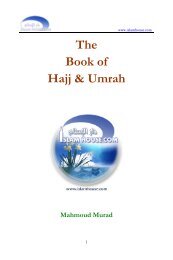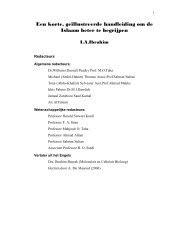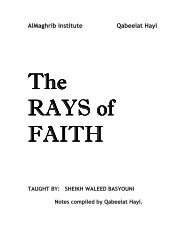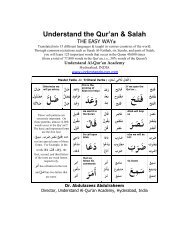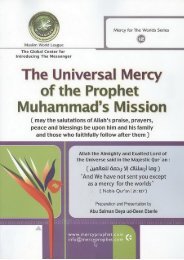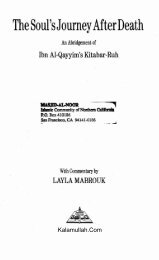The Life, Teachings and Influence of Muhammad ... - IslamHouse.com
The Life, Teachings and Influence of Muhammad ... - IslamHouse.com
The Life, Teachings and Influence of Muhammad ... - IslamHouse.com
Create successful ePaper yourself
Turn your PDF publications into a flip-book with our unique Google optimized e-Paper software.
43<br />
<strong>The</strong> <strong>Life</strong>, <strong>Teachings</strong> <strong>and</strong> <strong>Influence</strong> <strong>of</strong> <strong>Muhammad</strong> ibn Abdul-Wahhaab<br />
taken to him for a final decision. This included, as ibn Ghannaam <strong>and</strong><br />
ibn Bishr noted, matters related to zakat, finances, concluding peace<br />
treaties, sending <strong>of</strong> armies <strong>and</strong> so on. 1 <strong>Muhammad</strong> ibn Abdul-<br />
Wahhaab would also send emissaries to other leaders as well as meet<br />
<strong>and</strong> host other’s delegations. Hence, the whole intent <strong>and</strong> drive behind<br />
this new state was under the leadership <strong>of</strong> this religious scholar <strong>and</strong><br />
was thus <strong>com</strong>pletely different from what Najd had previously<br />
witnessed.<br />
Ibn Ghannaam, the closest <strong>and</strong> earliest chronicler, states that<br />
the first clash between the supporters <strong>and</strong> the opponents <strong>of</strong><br />
<strong>Muhammad</strong> ibn Abdul-Wahhaab came when Dahhaam ibn Dawwaas 2,<br />
the religious leader <strong>of</strong> the state. He was the source for religious rulings <strong>and</strong><br />
guidance, he sent teachers to other l<strong>and</strong>s <strong>and</strong> even appointed judges.<br />
1 Ibn Ghannaam, vol. 1, pp. 83-84; Ibn Bishr, vol. 1, p. 39.<br />
2 In the 1140’s or 1150’s, as Vassiliev (p. 62) noted, “Dahham ibn Dawwas seized<br />
power in Riyadh—he was to be al-Diriya’s most stubborn <strong>and</strong> merciless enemy<br />
for decades.” Indeed, the fighting between the followers <strong>of</strong> <strong>Muhammad</strong> ibn<br />
Abdul-Wahhaab <strong>and</strong> Dahhaam would last for some twenty-eight years. (Faisal<br />
<strong>and</strong> Saud, two sons <strong>of</strong> <strong>Muhammad</strong> ibn Saud, would lose their lives in one <strong>of</strong> the<br />
earliest battles against Riyadh. See ibn Ghannaam, vol. 1, p. 92.) Dahhaam’s<br />
father had been the ruler <strong>of</strong> Manfoohah. After his father’s death, Dahhaam <strong>and</strong><br />
his brothers were forced to leave Manfoohah as the people revolted against<br />
them. <strong>The</strong>y came to Riyadh, a city in flux with no strong ruler. After some time,<br />
Dahhaam became its ruler. However, the people <strong>of</strong> Riyadh hated him <strong>and</strong><br />
wanted to kill him. He called upon <strong>Muhammad</strong> ibn Saud, the Ameer <strong>of</strong> al-<br />
Diriyyah, to help him. Ibn Saud sent his brother Mishaari with some armed<br />
men <strong>and</strong> fought <strong>of</strong>f the insurgents. Mishaari stayed with Dahhaam for a few<br />
months but could not put up with his cruelty. Dahhaam had a woman’s mouth<br />
sewn up, he forced another man to cut <strong>of</strong>f a piece <strong>of</strong> his thigh <strong>and</strong> eat it slowly<br />
<strong>and</strong> so forth. Ibn Ghannaam stated, “Examples <strong>of</strong> such deeds are plentiful.” Cf.,<br />
Vassiliev, pp. 62-63. <strong>The</strong> length <strong>of</strong> the battles between Dahhaam <strong>and</strong> ibn<br />
Abdul-Wahhaab can be seen by the fact that Dahhaam is mentioned <strong>of</strong>f <strong>and</strong> on<br />
in ibn Ghannaam’s work from vol. 1, p. 89 until vol. 1, p. 136. It seems that<br />
Dahhaam was a true hypocrite. Ibn Abdul-Wahhaab wrote to him advising him<br />
to follow the Quran <strong>and</strong> Sunnah. Due to the help he had earlier received from<br />
<strong>Muhammad</strong> ibn Saud, he first appeared very sincere <strong>and</strong> helpful. However, ibn<br />
Abdul-Wahhaab’s teachings were spreading in Riyadh <strong>and</strong> this must have<br />
made Dahhaam fearful. He started a massive <strong>and</strong> cruel campaign against<br />
those followers. In fact, there were many times in which he broke his treaties<br />
<strong>and</strong> promises to the government <strong>of</strong> al-Diriyyah, causing the followers <strong>of</strong> ibn<br />
Abdul-Wahhaab a great deal <strong>of</strong> harm <strong>and</strong> suffering. He fought against them on<br />
many occasions, making alliances with numerous opponents <strong>of</strong> ibn Abdul-<br />
Wahhaab, <strong>and</strong> then he would return to pledge his allegiance to ibn Abdul-<br />
Wahhaab <strong>and</strong> the rulers <strong>of</strong> al-Diriyyah. On one occasion, ibn Ghannaam (vol. 1,<br />
p. 119) even wrote that his pledge was accepted though they knew that he<br />
would violate it but they did not want to stop anyone from accepting the path <strong>of</strong><br />
truth. For incidents with Dahhaam, see, for example, ibn Ghannaam, vol. 1, p.



